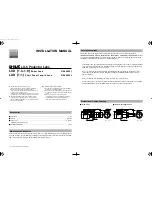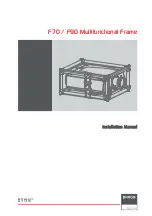
Webasto Thermosysteme
Roof-top air-conditioning system CC4E
Page 17 / 32
4.
INSTALLATION INSTRUCTIONS
4.1.
Safety precautions
The safety instructions set out in chapter 1.4 must be read and noted before starting work.
The system must be installed or supervised by personnel familiar with vehicle air-conditioning
systems.
4.2.
Installation kit
The basic scope of supply includes the following parts and materials in addition to the main components
roof-top air-conditioning unit and air-distribution panel:
a)
For mounting the roof-top air-conditioning unit with air-distribution panel
– 9 bolts M6 and 18 large washers, 9 small washers, 9 serrated washers and nuts M6, self-locking
– 10 self-tapping screws
– Sikaflex sealing compound
– 3 Armaflex sealing strips
– 9 spacers
4.3.
The following are not included in the installation kit and must be produced on site
– Air duct frame between roof and air-distribution panel
– Connecting cables and elements (vehicle side) (see Fig. 3.1 or 3.2)
– Fastening elements for routing the connecting cables
– Reinforcing elements, hoops inside the roof to ensure sufficient roof stability
4.4.
Required equipment, special tools and accessories
a)
For installation, the system is prefilled (R134a)
– Sheet metal cutter for breakthroughs in vehicle / cabin roof
– Mechanics tool kit
b)
For service (evacuation, filling and testing the refrigerant circuit)
– Servicing / recycling station for refrigerant R134a
– Vacuum pump, suction rate min. 5 m
3
/h, final pressure 1 Torr
– Filler hoses with quick-disconnect couplings for R134a
– Leakage tester
– Digital thermometer
– Refrigerant R134a
– Recycling cylinder for refrigerant R134a
– Cylinder connectors R134a
– Lubricating oil ZXL PAG 100 for Seltec refrigerating compressor
– Test fittings with intake-pressure and high-pressure gauges
– Spring balance or scales (min. 35 kg)
– Nitrogen cylinder with pressure reducer.
4.5.
Preparations on vehicle / cabin roof
– Installation depends on the type of vehicle. The vehicle manufacturer's instructions must
therefore be observed.
– Fig. 4.1 shows the installation dimensions and the mounting hole pattern of the roof-top unit. The
breakthroughs for the air intake and discharge openings are located off-centre in the baseplate.
















































